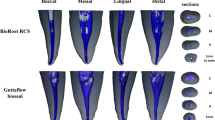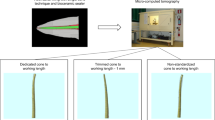Abstract
The objective of this study is to study the influence of final canal taper on the sealing ability of Real Seal 1 by using micro-computed tomography (micro-CT). Fifty-four single-rooted teeth were instrumented to apical size of 40 taper 4, 6, and 8. The teeth were divided into three groups. All teeth were filled with Real Seal 1 (RS1; SybronEndo, Orange, CA, USA). Roots were then scanned with mico-CT, and volume measurements of voids in the apical third and in sections at 1, 3, and 5 mm from the apex were calculated in the obturated roots using specialized CT software. Measurements were analyzed statistically by using ANOVA followed by Bonferroni multiple comparison correction. Data analysis showed that 0.08% and 0.06% apical tapered RS1 obturations provided better results than 0.04% tapered samples. The present study showed that none of the root canals filled teeth were gap free. Mean percentages of voids were significantly higher with Real Seal 1 taper 0.04% (P = 0.05).There was no significant difference with 0.06 and 0.08 final taper. For Real Seal 1 technique 0.06 and 0.08 tapered preparations seem to be more optimal. At 1 mm, final taper 0.08 showed less voids and gaps than the two other final tapers. In our daily practice, enlarging the apical third (last 3 mm) of root canals to an 8% taper is necessary to achieve a better sealing ability and thus long-term success for our root canal obturations.



Similar content being viewed by others
References
Epley SR, Fleischman J, Hartwell G, Cicalese C (2006) Completeness of root canal obturations: epiphany techniques versus gutta-percha techniques. J Endod 32:541–544
Da Silva Neto UX, de Moraes IG, Westphalen VP, Menezes R, Carneiro E, Fariniuk LF (2007) Leakage of 4 resin-based root-canal sealers used with a single-cone technique. Oral Surg Oral Med Oral Pathol Oral Radiol Endod 104:53–57
Schilder H (1967) Filling root canals in three dimensions. Dent Clin North Am 11:723–744
Johnson WB (1978) A new gutta-percha technique. J Endod 4:184–188
Whitworth J (2005) Methods of filling root canals: principles and practices. Endod Top 12:2–24
Jung M, Lommel D, Klimek J (2005) The imaging of toot canal obturation using micro-CT. Int Endod J 38:617–626
Saunders WP, Saunders EM (1994) Coronal leakage as a cause of failure in root-canal therapy: a review. Endod Dent Traumatol 10:105–108
Schneider SW (1971) A comparison of canal preparations in straight and curved canals. Oral Surg 32:271–275
Somma F, Cretella G, Carotenuto M, Pecci R, Bedini R, De Biasi M, Angerame D (2011) Quality of thermoplasticized and single point root fillings assessed by micro-computed tomography. Int Endod J 44:362–369. doi:10.1111/j.1365-2591.2010.01840
Huybrechts B, Bud M, Bergmans L, Lambrechts P, Jacobs R (2009) Void detection in root fillings using intraoral analogue, intraoral digital and cone beam CT images. Int Endod J 42:675–685
Tagger M, Tamse A, Katz A, Korzen BH (1984) Evaluation of the apical seal produced by a hybrid root canal filling method, combining lateral condensation and thermatic compaction. J Endod 10:299–303
Jarret IS, Marx D, Covey D, Karmazin M, Lavin M, Gound T (2004) Percentage of canals filled in apical cross sections: an in vitro study of seven obturation techniques. Int Endod J 37:392–398
Branstetter J, von Fraunhofer JA (1982) The physical properties of sealing action of endodontic sealer cements: a review of the literature. J Endod 8:312–316
Wu MK, Wesselink PR (1993) Endodontic leakage studies reconsidered. Part I. Methodology, application and relevance. Int Endod J 26:27–43
Wu M-K, Van der Sluis LWM, Wesselink PR (2002) A preliminary study of the percentage of the gutta percha filled area in the apical canal filled with vertically compacted warm gutta-percha. Int Endod J 35:527–535
Hammad M, Qualtrough A, Silikas N (2009) Evaluation of root canal obturation: a three dimensional in vitro study. J Endod 35:541–544
Metzger Z, Zary R, Cohen R, Teperovich E, Paqué F (2010) The quality of root canal preparation and root canal obturation in canals treated with rotary versus self adjusting files: a three dimensional micro-computed tomographic study. J Endod 36:1569–1572
Wu MK, Fan B, Wesselink PR (2000) Diminished leakage along root canals filled with gutta-percha without sealer over time: a laboratory study. Int Endod J 33:121–125
Kurtzman GM, Von Fraunhofer JA (2008) Research update: leakage resistance of a self-etch sealer-cone obturation system. Compendium 29:320–324
Boutsioukis C, Gogos C, Verhaagen B, Versluis M, Kastrinakis E, Van der Sluis LW (2010) The effect of root canal taper on the irrigant flow: evaluation using an unsteady Computational Fluid Dynamics model. Int Endod J 43:909–916. doi:10.1111/j.1365-2591.2010.01761
Testarelli L, Milana V, Rizzo F, Gagliani M, Gambarini G (2009) Sealing ability of a new carrier-based obturating material. Minerva Stomatol 58:217–224
Acknowledgments
The contribution of Gaël Bourbouze to this study is recognized and highly appreciated. The authors wish to thank Sybron Endo Europe for providing the tested materials. This work was supported by a grant from the research committee of Saint Joseph University, Beirut, Lebanon.
Conflict of interest
The authors declare that they have no conflict of interest or any financial relationship with the organization that sponsored the research.
Author information
Authors and Affiliations
Corresponding author
Rights and permissions
About this article
Cite this article
Zogheib, C., Naaman, A., Medioni, E. et al. Influence of apical taper on the quality of thermoplasticized root fillings assessed by micro-computed tomography. Clin Oral Invest 16, 1493–1498 (2012). https://doi.org/10.1007/s00784-011-0638-4
Received:
Accepted:
Published:
Issue Date:
DOI: https://doi.org/10.1007/s00784-011-0638-4




